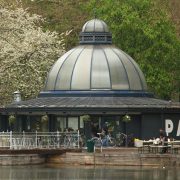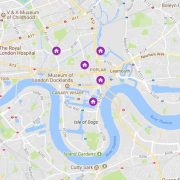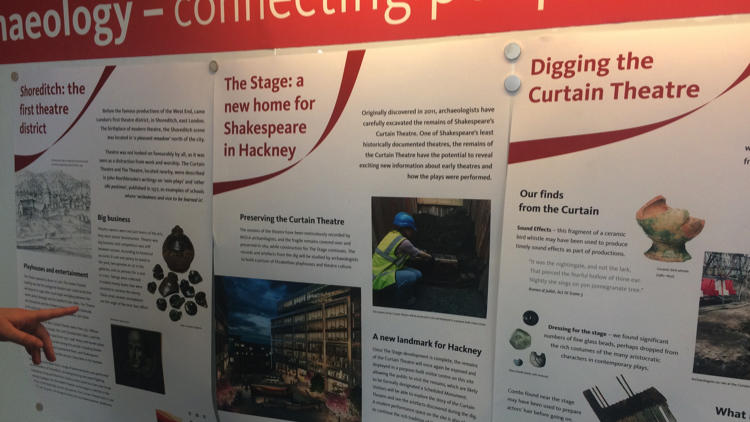
A timeline maps the discovery of the theatre’s remains. Pic; Natasha Chisabingo.
Situated right in front of Hackney Town Hall, the mobile Time Truck is impossible to miss while walking through central Hackney.
Run by the Museum of London Archaeology (MOLA), the Time Truck is a mobile event space regularly used to deliver a range of engagement activities across London. In this case, the truck has been brought to central Hackney in celebration of Shakespeare Week (March 20-24). Paul McGarrity explained why to Eastlondonlines.
He and many other MOLA archaeologists are working on the excavation of what used to be the Curtain Theatre in Shoreditch, Hackney.
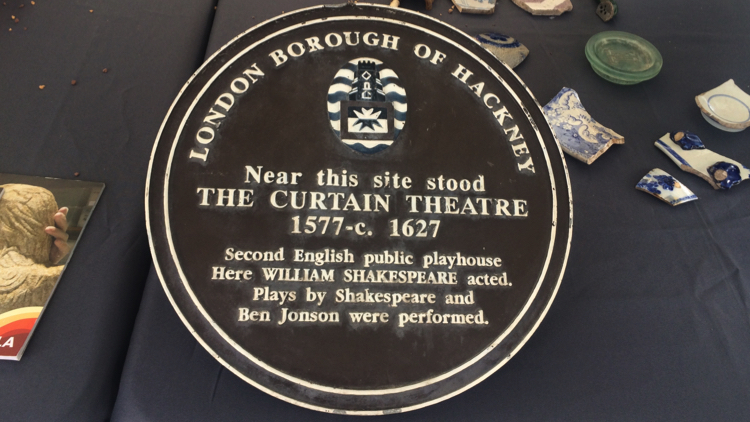
A plaque in Shoreditch commemorates the theatre’s fomer site. It will be used to mark the theatre’s new site. Pic; Natasha Chisabingo.
What a lot of people don’t realise is that the Curtain Theatre was the premiere venue for Shakespeare’s Company, the Lord Chamberlains Men, for a few years in the late 1500s.
“There’s always so much interest in the history of the arts and culture in East London,” McGarrity said. “So for one of Shakespeare’s theatres to have been based right here in Hackney, we felt it was important to share some of our discoveries and plans to people who otherwise may not have known anything about the excavation.”
Following the discovery of remains by MOLA in 2012, teams of archaeologists have been continuously working on excavating the site for development, with never-before-seen artefacts and relics now on display around the area, and now in the Shakespeare Time Truck.
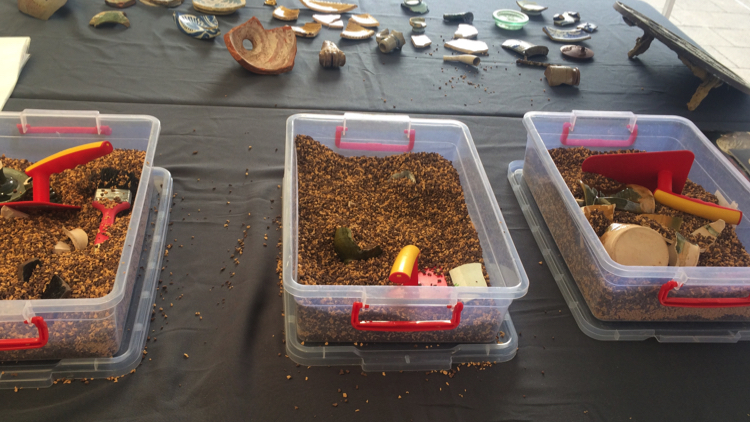
An area for children, designed to replicate excavation. Pic; Natasha Chisabingo.
It’s clear to see that MOLA do not focus on the quantity of artefacts or filling every angle of the space unnecessarily, but rather on making sure everything they display is key in illustrating elements of life at the time with historical significance.
A time map covers the wall on entry, so you are immediately met with the key information, outlining the timeline of events. It begins with a brief history of playhouses and theatres during the 1500s, breaking down the story behind Shakespeare’s company occupying the Curtain Theatre and ending with real-time photographs of the current progress on the site.
In just a few moments, even someone with no prior knowledge of the history of the Curtain Theatre can feel up to date and well informed without being bombarded by an overwhelming level of facts and figures.
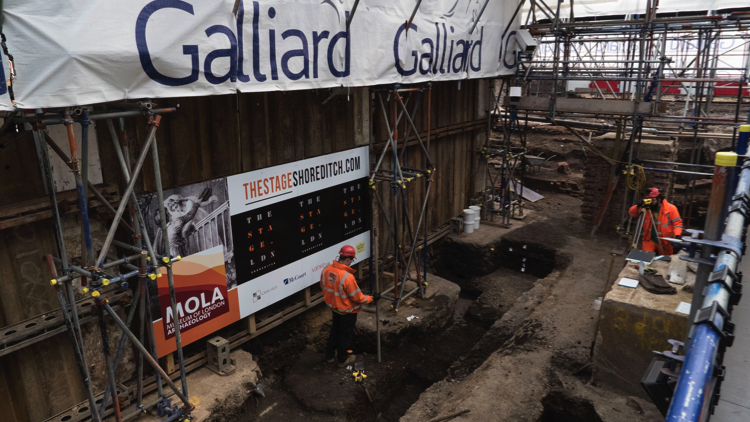
Archaeologists digging at The Curtain Theatre during excavation in 2016. Pic; Jwslubbock (Wikimedia Commons)
Much of the space is occupied by a table dotted with artefacts, relics and various other remnants of what would have been key components in the daily running of the theatre. Alongside them are images which clearly illustrate what certain pieces may have looked like.
A glass case holds several smaller pieces which ELL were told are the crème de la crème of the archaeologist’s findings thus far including the tops of what would have been money jars and smoking pipes of various sizes
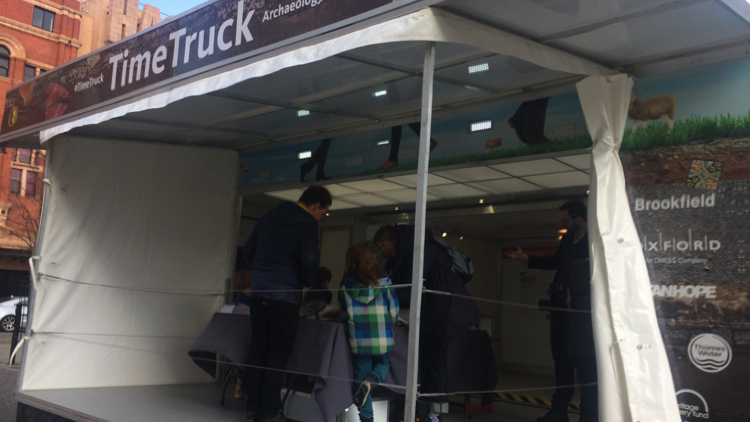
The Time Truck at its pop-up location outside Hackney Town Hall. Pic; Natasha Chisabingo.
Most standout piece, however, was a drinking jug still in almost perfect shape. It is easy to examine the markings of its early craftsmanship still present on its surface.
The fact that objects such as these are still able to be seen and observed decades later makes it clear why the work of organisations such as MOLA is so key. Instead of being left buried beneath debris, pieces of history are able to be joined together through their discoveries.
MOLA Time Trucks are occasionally used for various activities, some of these being educational; this is re-iterated with a small area of the truck, designed for children to interact with and understand the work of the archaeologists. The exercise is being piloted for future use with Key Stage Two pupils in the Hackney area.
Designed to model the actions of excavating, children can practice digging through sand boxes where they discover mock artefacts hidden in the boxes. Through this activity the children are learning about the work as well as providing an opportunity for the archaeologists to throw in quick ‘fun facts’ about the relics they find.
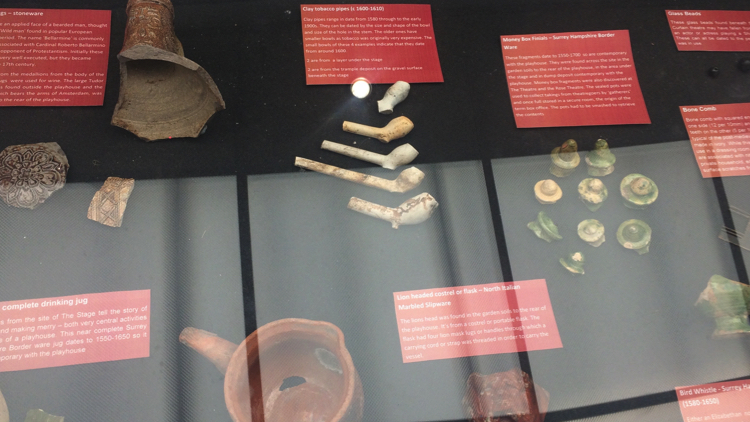
Valuable and fragile artefacts are stored in glass casings to maintain their craftsmanship. Pic; Natasha Chisabingo.
Although it was only there for a day, the Time Truck experience was one truly worthwhile. It serves as an interactive time capsule, allowing for an informative and equally interesting experience. Being free of charge is just a bonus.
While the Time Truck is not an ongoing exhibition but rather a regular planned event, anyone interested in viewing artefacts retrieved during the rediscovery may have to wait some time to observe them at the anticipated Shakespeare Museum which will be based on location in Shoreditch, expected to be completed in 2019.

